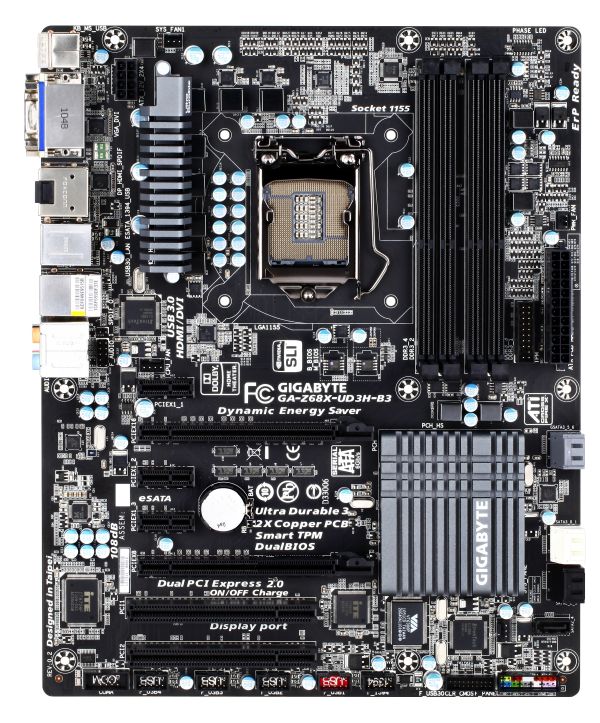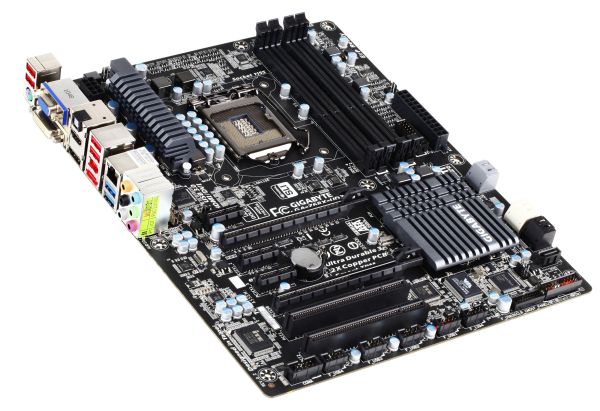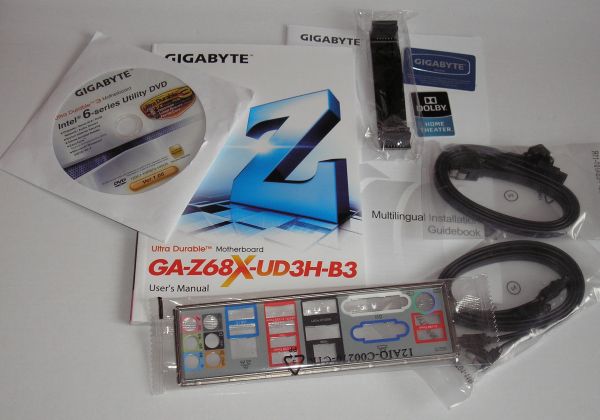Gigabyte Z68X-UD3H-B3 Review
by Brendan van Varik on July 11, 2011 7:01 AM EST- Posted in
- Gigabyte
- Motherboards
- Sandy Bridge
- Z68
Gigabyte has released their Z68 lineup, and today I am going to look at the UD3H - a $170 Z68 board aimed at the mainstream consumer market. The Z68 based motherboards are very similar to the P67 equivalent but they have had a few extra features added. They include Virtu and SSD caching as well as allowing you to take advantage of the GPU built into your Sandy Bridge processor. Is it worth switching from P67 to Z68 for a few extra features? Well, after what I have seen, no, not really.
Visual Inspection
Just like most of Gigabyte's latest range, they have gone with the black and gray theme for this motherboard. In my eyes, it looks very classy and professional.
Gigabyte engineers have used their heads when it comes to the PCIe layout. There’s plenty of room for dual GPU configurations and there’s even a slot for breathing space when utilizing dual slot GPUs. From top to bottom, we have a PCIe 1x, 16x, 1x, 1x, another 16x and two PCI slots. When two GPUs are used, the PCIe 16x lanes run at 8x/8x.
As the PCH heatsink is small and passive, so if dual GPUs are utilized, there may be a heat conductance issue on to the heatsink if there is a lack of airflow. Some aftermarket graphics card coolers vent hot air into the case which will also cause the PCH to warm up if the chassis isn’t vented properly. In fact, when the board was put through its paces on the test bed, the PCH heatsink got very warm to the touch if there was no fan pointed at it.
There is a regular looking I/O panel. The picture above details the selection of connectivity options at the back of this motherboard. A PS/2 port which can be used for either a keyboard or a mouse but not both at the same time. There are a total of four USB 2 and two USB 3 ports, an eSATA 3Gb/s port as well as a FireWire port. The display ports include DVI, VGA, HDMI and a display port. The HDMI and DisplayPort connections carry audio. The single Ethernet port is controlled by the Realtek RTL8111E chip. You can use either the SPDIF or the typical audio connections for your sound.
With regards to the SATA connections, we have three (internal) SATA 3Gb/s connections and four SATA 6Gb/s ports. There is an eSATA port on the I/O of the motherboard which takes the total of SATA 3Gb/s ports to four. Two of the four SATA 6Gb/s ports are controlled by a separate controller – a Marvell 88SE917. These are colored gray and have support for RAID 0 and 1. The rest of the SATA ports are controlled by the Intel Z68 chipset and allow for RAID 0, 1, 5 and 10. You are able to create a RAID array across the SATA 3Gb/s and 6Gb/s ports although the performance may vary (according to Gigabyte).
After comparing to other motherboards, the SATA layout is a tad odd. On most motherboards, you would typically find a row of SATA connectors that are adjacent to each other and then color-coded accordingly. Even though it is only one port which points out of the board and the rest stick out of the side, it looks odd and it doesn’t make sense why this has been done.
A total of four fan headers can be used on this motherboard. There is one for the CPU cooler and three for chassis fans. The CPU fan header is not located in a familiar position as you’d find with other motherboards - it’s in the center board just above the PCIe 1x slot. The two system fans are on opposite sides of the board - one is located just above the VRM heat sink and the other is located just below the PCH heat sink. It would have made more sense to use the header located above the VRM heat sink as the CPU header and vice versa. The PWR fan header is located just above the 24pin power which just like SYS_FAN1 does not allow for speed control.
What is included in the box?
A user’s manual and a multilingual guidebook.
- Driver and utilities DVD
- 2x SATA 6Gb/s cables
- 2x SATA 3Gb/s cables
- A SLi bridge
- I/O shield
- 1x Gigabyte case sticker
- 1x DOLBY case sticker
You do not get many extras with this motherboard. In fact, it is pretty minimalist. Just like other manufacturers, Gigabyte have included the essentials to get your system up and running, and nothing more. If you want more accessories such as the 3.5” front panel with two USB 3.0/2.0 ports or a SATA bracket, you will have to buy the more expensive, higher end models.















70 Comments
View All Comments
Brutus1234 - Monday, July 11, 2011 - link
I bought one of these from Newegg a couple weeks ago and I'm very happy with it.2600K with a 45x multiplier for 4.5GHz
GSKill RipSaw DDR3 ( 4 Gig ) - system recognizes memory as 2133 with enhanced profile
H70 Corsair Water Cooler
Runs great, Have not touched voltage - it's still all stock.
I've stressed tested it, running some h264 encodes, getting nearly 100% utilization on the CPU for 6hrs and never a hiccup. Temp rarely cracks 50C on the CPU. Very happy with this build
Only thing I have issues with is the Virtu Softare. It recognizes the board but I thought I was getting a licence to use it, and all I can get is a demo mode.
Patrick Wolf - Monday, July 11, 2011 - link
So they implement TouchBIOS but not a GUI? That's just being lazy. FFS, even Biostar has a GUI. Then of course there's the boot loop issue that wasted a lot of my time.http://www.overclock.net/intel-motherboards/103472...
789427 - Monday, July 11, 2011 - link
GUI for bios is *really* a waste of time. Imagine having to connect a keyboard AND a mouse to fix the machine when it breaks...That's like finding a use for a mouse in DR Dos 6.0
Awesome motherboard... lack of fan control shouldn't be too problematic.
Just had a thought though.... if CPUs were delivered in larger packages with the connectors situated off-die, with a vertical arrangement it would be possible to cool both sides of the die at once in a sandwich style cooler.
Twice the surface area to cool means that we'd be in overclocking heaven!
Now we just need Intel to decide to change the sockets again!
86waterpumper - Monday, July 11, 2011 - link
I agree with EnzoFX. If the bios does not cause a boot time slowdown that is pretty well a non issue. However, this day and age lack of fan control in the bios is more than stupid. More and more you are going to see a move to more efficient and power saving features. There is no point in a cpu clocking down and powergating and idling if the fan is going to blast on along like a jet. This is especially true for htpc use which alot are going to use the sandy bridge z68 for. Speaking of that, gigabyte is the one that actually has a z68 board out without a video out on the board at all right? What are they smoking these days :PThe0ne - Monday, July 11, 2011 - link
"Based on the benchmarks and performance figures seen in this review, it shows that you do not have to spend big amounts of money on a motherboard to get on to the Z68 platform. A motherboard that could arguably be aimed at the budget end of the spectrum has performed well "This would fit my needs perfectly. Just wondering why with the comment above it's not a "pick" from you/Anandtech? What's lacking to make it so?
jigglywiggly - Monday, July 11, 2011 - link
U GRAMMAR FARTSSTFU
READ THE ARTICLE FOR THE INFO
fb39ca4 - Monday, July 11, 2011 - link
How is $170 a budget motherboard? This is mid range territory.ratbert1 - Monday, July 11, 2011 - link
Enjoying your baptism by fire? I was going to post about the grammar, but it seems to have all be said.Mr Alpha - Monday, July 11, 2011 - link
Why not run CDM in 0xFF fill mode? Sure, the perfectly compressible data is unrealistic, but it would largely take the flash out of the equation making the benchmark purely about the interface. And when benchmarking a motherboard is it not the limits of the interfaces it provides that really matter?nemitech - Tuesday, July 12, 2011 - link
The test does;t say what version of Lucid was used on the Gigabyte MB vs the Asus one. a new version was released yesterday on the Gigabyte site:http://www.gigabyte.com/products/product-page.aspx...
I can't see any hardware reason that the Gigabyte should be slower than the Asus. Maybe there is a BIOS or Lucid driver update that brings the performance back in par. that is the probelm with reviews, issues are rarely revisited or updated leaving a bad opinion about a product.
This is defiantly a budget MB - I got mine for $105 (!) after $15 rebate, at microcenter this past weekend, with a 2500k for $180. What a bargain. :-)